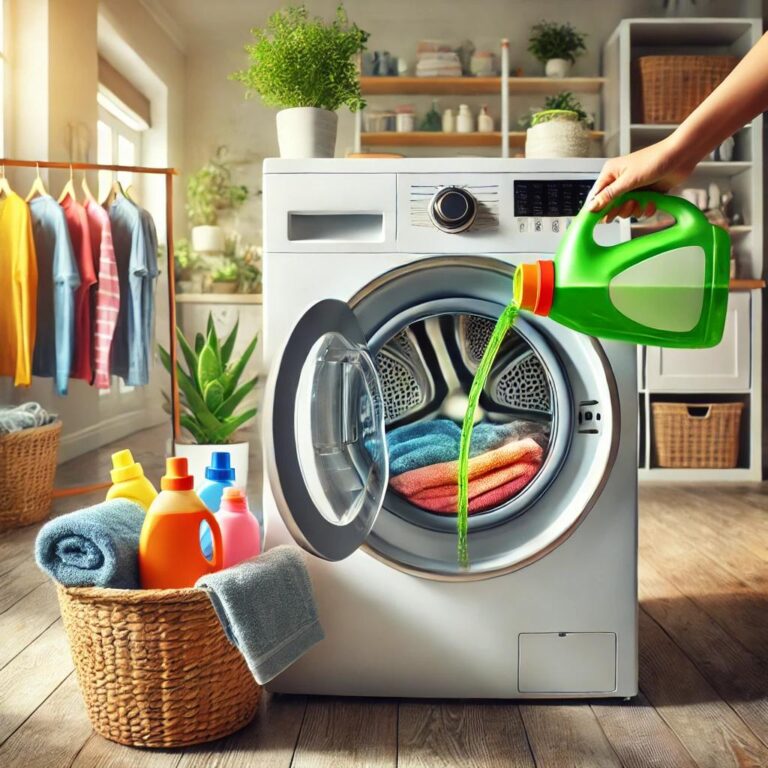ADVERTISEMENT
- Pre-soak: For stubborn stains or yellowing, mix a solution of 1 cup of vinegar with 2 cups of water in a basin or your bathtub. Let your white clothes or towels soak for 30 minutes to an hour. After soaking, wash them as usual.
- In the Wash: Add 1/2 cup of white vinegar directly to the washing machine during the wash cycle. The vinegar’s acidity helps remove soap residue and brightens white fabrics, leaving them looking fresher.
- Lemon Juice for Extra Whitening: For added brightness, you can combine vinegar with lemon juice. Lemon is a natural whitener and can help lift stains from fabrics. Add 1/4 cup of lemon juice to your vinegar in the wash cycle for an extra boost.
3. To Remove Odors:
Vinegar’s deodorizing properties can be a game changer for towels and clothes that have absorbed bad odors—especially towels that have been left damp or clothes that have been sitting in the laundry basket too long.
- Pre-Treat Smelly Clothes: For clothes that have absorbed odors, pre-soak them in a solution of 1 cup of vinegar and 2 cups of water before washing. This helps neutralize smells before they are laundered.
- Add to Wash Cycle: Add 1/2 cup of vinegar to the washing machine along with your regular detergent. The vinegar will help neutralize odors, leaving your clothes and towels smelling fresh and clean.
4. To Combat Fabric Softener Residue:
Over time, fabric softeners can build up on clothing and towels, leading to a waxy or greasy feeling. Vinegar works wonders to break down this residue, leaving fabrics feeling truly soft and clean.
- Add Vinegar to the Rinse Cycle: Add 1/2 cup of vinegar to the rinse cycle to help remove any lingering fabric softener residue. This step will also help make your clothes and towels softer without using more chemical softeners.
5. For a Cleaner Washing Machine:
Your washing machine can accumulate detergent and fabric softener buildup over time, which can affect the performance of the machine and even leave a musty smell on clothes and towels.
- Clean the Machine: Run an empty cycle on the hottest setting with 2 cups of vinegar in the drum. This will help clean out any residue and disinfect the interior of the washing machine.
Tips for Using Vinegar in Laundry
- Always Use White Vinegar: Stick with white vinegar for laundry purposes. Apple cider vinegar and other types of vinegar may leave stains or scents on your clothes.
- Don’t Overuse: While vinegar is a powerful natural cleaner, it’s not necessary to use it in every load. Reserve it for when you need to refresh towels, restore whites, or remove odors.
- Test on Delicates: If you have delicate fabrics (like wool or silk), test vinegar on a small, inconspicuous area first to ensure it won’t damage the fabric.
- Avoid Mixing with Bleach: Never mix vinegar with bleach as it can release harmful gases. Use one or the other for best results.
Vinegar in Your Laundry Routine: A Quick Recap
- For softer towels: Add 1/2 to 1 cup of white vinegar to the rinse cycle.
- For whiter whites: Add 1/2 cup of white vinegar to the wash cycle or soak whites in a vinegar-water solution before washing.
- To remove odors: Pre-soak clothes or towels in a vinegar-water solution or add 1/2 cup of vinegar to the wash.
- To clean your washing machine: Run an empty cycle with 2 cups of vinegar to eliminate buildup.
Why Vinegar is the Ultimate Laundry Helper
Vinegar is not only a cheap and natural solution to your laundry woes, but it also does a fantastic job of making your clothes and towels feel fresh and soft while keeping them looking their best. By incorporating vinegar into your laundry routine, you can avoid the harsh chemicals often found in fabric softeners and bleaches, all while maintaining a sustainable and eco-friendly approach to your laundry.
The next time you’re doing laundry, remember: a little vinegar goes a long way. It’s the secret to whiter whites, softer towels, and fresher laundry—all for a fraction of the cost of commercial products.
ADVERTISEMENT
ADVERTISEMENT
